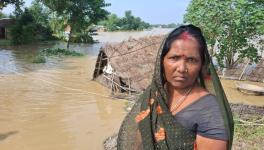Bihar: After Arsenic, Health Concerns Over Uranium Contamination in Groundwater
Representational use only.
Patna: After arsenic, a study has found uranium contamination in groundwater in Bihar, raising concerns over its detrimental impact on people’s health. However, the state’s Public Health Engineering Department says it does not know about the study.
Ashok Kumar Ghosh, one of the leading scientists of the research team and chairmain of Bhar Pollution Control Board, on Wednesday said that he had submitted the research study to the Public Health Engineering Department for follow up measures.
“The PHED may have initiated the process for measures to deal with finding of uranium and arsenic contamination in drinking water in the state. They might have conducted their own internal survey to assess the study,” Ghosh said.
He further said that based on the result of the research study, entitled Distribution and Geochemical Controls of Arsenic and Uranium in Groundwater-Derived Drinking Water in Bihar, his team of researchers along with IIT Kharagpur and Roorkee have started working on the geological origin of uranium and arsenic contamination in drinking water. ”We have identified three locations for drilling, including Bhagalpur, Maner in Patna and Bhojpur districts,” he said.
However, D S Mishra, engineer in chief, PHED, said he had no knowledge of any such study. “If there is any such study, we will validate the data from our own team. But it is a matter of concern as the study has reportedly found uranium contamination in drinking water,” he said.
Mishra said arsenic contamination was well known and PHED worked to provide safe drinking water to people exposed to it. “In the last two years, we have started measures to deal with arsenic contamination,” he said.
As per the study, funded by the University of Manchester (UK) and Mahavir Cancer Sansthan and Research Centre in Patna, the concentrations of arsenic and uranium are highly heterogeneous across Bihar. The arsenic and uranium concentrations also exceed World Health Organisation (WHO) (provisional) guideline values in 16% and 7% of samples, respectively. The strongly inverse correlation between arsenic and uranium is consistent with the contrasting redox controls on arsenic and uranium mobility.
Ghosh said, “Uranium contamination in groundwater, which is widely used for drinking in the state, is a matter of serious concern as it will be hazardous to the health of those exposed. Our study has found the presence of uranium contamination in the groundwater in the state.”
He added, “With carcinogenics in uranium, it is dangerous to health; high exposure may cause bone toxicity and impaired renal function and cancer.”
The study shows that uranium concentrations are elevated primarily in the North West–South East band along and to the east of the Gandak river and running south of the Ganga river toward Jharkhand, particularly in Gopalganj, Siwan, Saran, Patna, Nalanda and Nawada districts.
High uranium water samples were also found in the Supaul district (highest found in this study), which appear to be more isolated. Elevated uranium to the south of the Ganga, especially in the southwestern districts of Aurangabad, Gaya, Jahenabad, Nalanda and Nawada, is consistent with previous work in Patna.
The results of the study show that uranium varies significantly and is elevated in some parts of Patna. Previously it had been reported to be well below permissible limits in several blocks of Patna.
According to the study, the districts where uranium exceeded WHO provisional guidelines in at least one sample include Bhagalpur, Gopalganj, Katihar, Munger, Muzaffarpur, Nalanda, Nawada, Patna, Saran, Siwan, Supaul and Vaishali. There is a stark geographical contrast, with districts South of the Ganga typically showing higher uranium and lower arsenic than districts north of the Ganga.
According to the study, in Singhbhum district (which was previously part of Bihar and now in Jharkhand state), uranium mineralisation is associated with Cu(Copper), Ni(Nickel) and sulphides in the Singhbhum shear zone, especially the uranium-enriched Central zone between Jaduguda–Bhatin–Nimdih and Narwapahar–Garadih–Turamdih. Elevated Uranium concentration was also found in paleo-interfluvial groundwaters in the Bengal Basin.
The study has made it clear that the concentration of arsenic tends to be higher in areas near the north of Ganga River, particularly in the zone between the Gandak and Koshi tributaries and near the Nepal border. The highest overall arsenic concentration observed was in non-randomised samples from a hotspot in the Samastipur district.
According to Ghosh, the study observed that despite relatively low sampling density, the spatial coverage across all districts in Bihar provides, for the first time, a comprehensive and consistent dataset for (inorganic) geochemical groundwater characterisation in Bihar.
Bihar’s groundwater has severe arsenic contamination. Out of its 38 districts, 22 were reported to have arsenic in drinking water above the WHO provisional guide value of 10 μg / L. More than nine million people were estimated to be drinking water with arsenic above 10 μg / L, and 33% of the tested hand tube wells samples usually used for drinking water had arsenic above the WHO provisional guide value.
Another recent scientific research study has revealed that in rural Bihar, arsenic poisoning is not only seen in drinking water but also in the food chain, mainly rice, wheat and potato. There is an urgent need to monitor irrigation water quality along with drinking water.
Ghosh said arsenic in drinking water is not new in Bihar; the unique observation of the study, he said, was that in many samples, arsenic content in food items was higher than the drinking water. A higher concentration of arsenic was found in cooked rice compared with raw rice.
Get the latest reports & analysis with people's perspective on Protests, movements & deep analytical videos, discussions of the current affairs in your Telegram app. Subscribe to NewsClick's Telegram channel & get Real-Time updates on stories, as they get published on our website.























